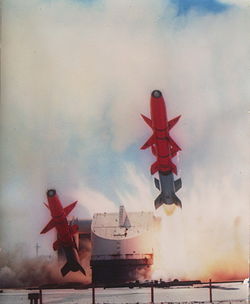- Operation Bumblebee
-
 RIM-8 Talos test firing
RIM-8 Talos test firing
Operation Bumblebee developed and tested US Navy ramjet missiles at the end of World War II. The Applied Physics Lab PTV-N-4 Cobra/BTV (Propulsion Test Vehicle/Burner Test Vehicle)[1] was flown in October 1945,[2] and the program developed the operational RIM-8 Talos missile.
Contents
Origin
Navy ships were hit by air-launched Henschel Hs 293 glide bombs and Fritz X anti-ship missiles during 1943. A ramjet-powered anti-aircraft missile was proposed to destroy aircraft launching such weapons while remaining beyond the range of shipboard artillery.[3] Initial performance goals were target intercept at a horizontal range of 10 miles and 30,000 feet altitude, with a 300 to 600 pound warhead for a 30 to 60 percent kill probability.[4] Heavy shipping losses to Kamikaze attacks during the Battle of Okinawa provided additional incentive for guided missile development.[3]
Field testing
In addition to initial tests at the Island Beach, New Jersey, and Fort Miles, Delaware, temporary sites,[5] Camp Davis, North Carolina, was used for Operation Bumblebee from c. June 1, 1946, to July 28, 1948.[6] Topsail Island, North Carolina, became the permanent Bumblebee testing and launch facility in March 1947.[5] The Topsail Historical Society hosts the Missiles and More Museum at the site. Testing was transferred to Naval Air Weapons Station China Lake and then to White Sands Missile Range in 1951 where USS Desert Ship (LLS-1) was built as a prototype Talos launch facility.[3]
Program results
The RIM-2 Terrier, devised as a test vehicle, became operational as a fleet anti-aircraft missile aboard USS Boston in 1955, and evolved into the RIM-66 Standard. Talos became operational with the fleet aboard USS Galveston in February, 1959, and saw combat use during the Vietnam War. Ramjet knowledge acquired during the program aided development of the XB-70 Valkyrie and the SR-71 Blackbird.[citation needed] Solid fuel boosters developed to bring the ramjet to operational velocity formed the basis for larger solid fuel rocket motors for ICBMs, satellite launch vehicles and the space shuttle.[4]
References
- ^ Parsch, Andreas. "PTV-N-4". http://www.designation-systems.net/dusrm/app1/ptv-n-4.html. Retrieved 2009-07-30.
- ^ Parsch, Andreas. "Cobra-BTV". astronautix.com. http://www.astronautix.com/lvs/cobrabtv.htm. Retrieved 2009-03-19.
- ^ a b c "A Brief History of White Sands Proving Ground 1941-1965". New Mexico State University. http://nmsua.edu/tiopete/files/2008/12/wspgcoldbook.pdf. Retrieved 2010-08-19.
- ^ a b "Talos Missile History". Hays, Philip R.. http://www.okieboat.com/Talos%20history.html. Retrieved 2010-08-19.
- ^ a b "US Naval Ordnance Test Facilities, Topsail Island MPS". From Sand Dunes to Sonic Booms. NPS.gov. http://www.cr.nps.gov/nr/travel/aviation/usn.htm. Retrieved 2009-03-19.
- ^ Jones, Wilbur D. (Jr) (2005). The Journey Continues: The World War II Home Front. Shippensburg, PA: White Mane Books. p. 83. ISBN 1-57249-365-8.
External links
Categories:- Military projects of the United States
- Secret military programs
- Code names
- Naval surface-to-air missiles of the United States
- Naval weapons of the United States
- Nuclear anti-aircraft weapons
- Surface-to-air missiles of the United States
- United States military history stubs
Wikimedia Foundation. 2010.
